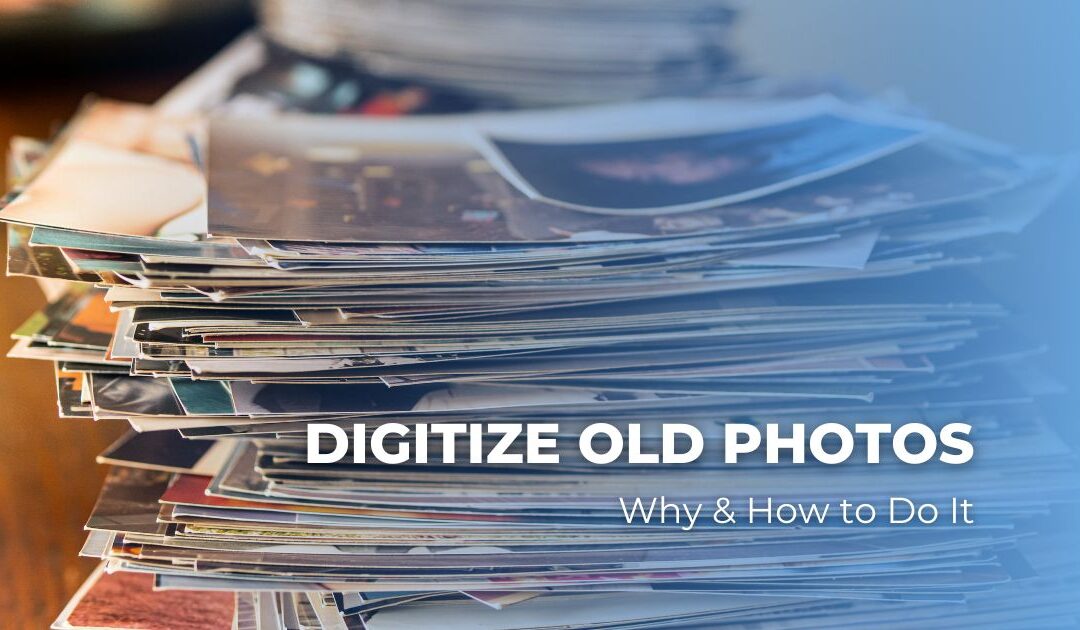There’s nothing quite like flipping through old family photo albums and seeing your parents or grandparents when they were young. These photos are something to be cherished forever so that the memories can stay with you, even when the people in the pictures are gone.
The problem is that photographs aren’t forever—especially not old photographs. The images fade, the corners fold, the gloss finish cracks and separates from the photograph, and the memory can be lost to the ravages of time.
This is why it’s such a good idea to get your old photographs digitized. Need more convincing? Keep reading…
Keep Photos in Good Condition Forever
A digital photograph is much easier to preserve than a traditional one, especially one that’s already a few decades old and has started to degrade. Additionally, if you back the image file up to the cloud and on a separate hard drive, you’ll have protection against disasters like floods or fires that can destroy everything in a home.
Another bonus of digitizing is that you can actually recover some of the detail in a photograph that has already started to degrade. You may even end up with a better version of the photograph to display than the original. Sure, you’ll never be able to completely recover everything, but you can certainly sharpen up some details, carefully remove folds or scratches, and bring back the colors (if there were any to begin with).
Organization and Storage Become Easier
Digital storage takes up a lot less space in your home. If you’re like most people who had a camera before the early 2000s, you probably have boxes of printed photographs and lines of negatives taking up space in a closet or drawer somewhere in your home. When you digitize your photos, you can get rid of most of those space-wasters because you’ll have a perfect copy on your computer and in the cloud.
It’s also much simpler to organize your photographs. As you go through the process of digitizing, stay on top of the process by putting photographs into folders with the dates on them and maybe even descriptive details like where the photos were taken. Now you have an archive of family photos that you can search through using a computer’s search function.
You Can Share Your Photos with Greater Ease
Following on from better organization comes the ability to share your photographs with greater ease. If it’s simple to find a photograph from a specific time and place, you can easily locate the image you want on your computer.
You can then share the picture through a myriad of options, whether via email, social media or even just a link to your cloud storage. This ensures that even if you have family or friends on the other side of the world, they get to enjoy the photographs too, and there’s no worry about them getting damaged in transit.
Four Ways to Digitize Old Photographs
Now that you know why you should digitize your old family photos, let’s look at how best to do that:
1. Taking a Photo of Your Photo
The quickest way to digitize a photograph is to simply take a photograph of the image. You can even use your smartphone’s camera to do this. Many smartphones take an extremely high res image that gives you plenty of detail for the retouching process if necessary.
The biggest downside to going for this method is that you will struggle to get away from a section of glare on the photograph unless you can set up your photo with good, soft, general lighting. You will also have to crop out the background, meaning you have to ensure that your camera is perfectly square with the photograph to get clean edges.
Additionally, while it can be an efficient way to scan your photos, the quality of your scan will not be ideal for reprinting in photobooks and other keepsakes.
You do get some scanner apps for smartphones that can make the process a bit easier. However, they’re not the perfect solution for preserving pristine memories.
2. Using a Photo Scanner
The next option is to use your computer and a scanner created for scanning pictures. This will give you a decent quality image that you can edit and crop. In fact, some scanners will auto-detect the image and crop it for you. It is, however, important that you invest in a high-quality scanner if you have a lot of photographs that you want to preserve. A regular document scanner can only do so much to detect detail in an older, slightly faded photograph.
You also need to consider that going with this method requires a lot of your time. You’ll be the one scanning in each photograph and doing any edits needed. The upside of this is that you’re there to do the cataloging and organizing as you go.
Another method is camera scanning where you use professional-grade camera equipment to scan photographs. To learn more about camera scanning, check the Camera Scanning Simplified course.
3. Opting for a Professional Service
The final option is hiring a pro, and this is often the best choice if you want great results. A professional digitizing company will have all the high-quality and expensive equipment for getting the best version of your photograph copied and digitized. They can also create digital photo books or collections that you can cherish and share with your loved ones.
However, it’s important that you organize all the photographs properly before you hand them over so that you aren’t left with the mammoth task of sorting through the digital copies afterwards.
Going this route will give you the best end result in terms of the finished product.
Keep the Memories Alive and Always with You
Whichever route you choose for your digitizing, know that you’re making an investment into your family and your history. You’re keeping your memories alive and the memories of the people who came before you. It’s a great means of preserving your stories, saving family portraits of those who’re part of your history, and recording where you’ve been and what you’ve accomplished.
Just remember—stay organized as you digitize. That way, you’ll get the most out of the process and really get to enjoy all of your family portraits.
 Author:
Author:
Sydney Evans is a self proclaimed photophile and a content writer for various online photography outlets. She covers topics ranging from creative compositions, photography techniques, as well as advertising and promotions. In her free time, she carries a camera over her shoulder and takes snaps of subjects she finds fun and have deeper meaning.


Recent Comments